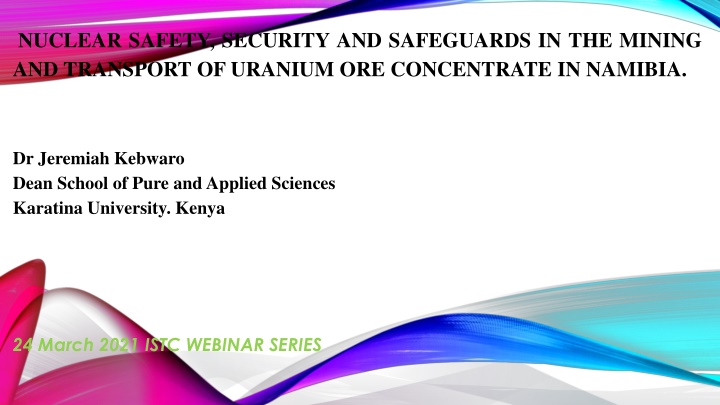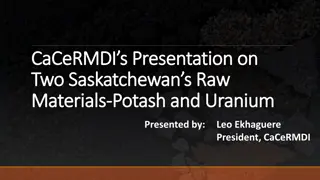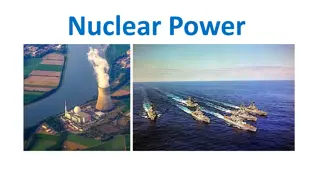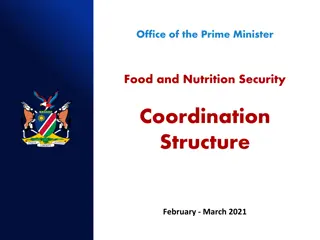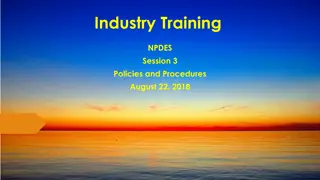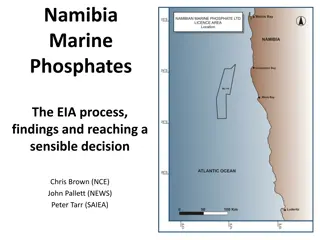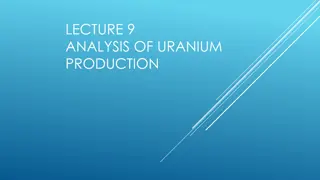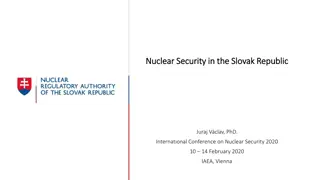Nuclear Safety and Security in Uranium Mining in Namibia
This report discusses nuclear safety, security, and safeguards in the mining and transportation of uranium ore concentrate in Namibia. It explores the current frameworks, challenges, and opportunities, aiming to strengthen the existing policies and propose strategies for regional alignment. The methodology involved desk-based research and a review of relevant laws, policies, and agreements. Namibia's country profile, transport infrastructure, and economic dependence on natural resources like uranium are also analyzed.
Download Presentation

Please find below an Image/Link to download the presentation.
The content on the website is provided AS IS for your information and personal use only. It may not be sold, licensed, or shared on other websites without obtaining consent from the author.If you encounter any issues during the download, it is possible that the publisher has removed the file from their server.
You are allowed to download the files provided on this website for personal or commercial use, subject to the condition that they are used lawfully. All files are the property of their respective owners.
The content on the website is provided AS IS for your information and personal use only. It may not be sold, licensed, or shared on other websites without obtaining consent from the author.
E N D
Presentation Transcript
NUCLEAR SAFETY, SECURITY AND SAFEGUARDS IN THE MINING AND TRANSPORT OF URANIUM ORE CONCENTRATE IN NAMIBIA. Dr Jeremiah Kebwaro Dean School of Pure and Applied Sciences Karatina University. Kenya 24 March 2021 ISTC WEBINAR SERIES
INTRODUCTION This is a report under EU funded Project MC 5.01/15b Support to the Southern African States in Nuclear Safety and Safeguards. The report presents a case study of Namibia and analyzes the country s declared uranium exploitation status; The existing legal and institutional frameworks and implementation capacities.
Goal of the study The goal of this study was to review the current safety, security and safeguards policies and regulations for uranium mining and transportation in Namibia and identify challenges and opportunities in the current frameworks. Propose strategies for strengthening the existing framework and a roadmap for regional approximation
METHODOLOGY Desk-based research, including an extensive review of the laws, policies, regulations and agreements that govern the national mining sector, as well as relevant literature on the sector that include Annual reports compiled by the mining companies. Relevant Agency documents that include IAEA GSR ,IAEA NSS, IAEA TS-G UN regulations on transport of dangerous goods ST/SG/AC.10/1/Rev.21 The review also included study of the united nations country reports and approved committee matrixes in the United nations 1540 UN committee resolutions.
COUNTRY PROFILE Namibia is found in the Southern part of Africa, and is bordered by four countries; Zambia, Angola, Botswana and South Africa. It services land-locked SADC countries such a Botswana and Zambia. The Namibian economy is heavily dependent on the extraction and processing of natural resources such as uranium. MAP from (Odendaa and Hebinck, 2020)
Transport infrastructure Namibia has a well-established road infrastructure, and The majority of towns and communities can be reached via a road network. Namibia has 4 transport corridors ,Trans-Kalahari via Bostwana, Trans-Caprivi, Trans-Cunene via Angola to DRC and Trans-Oranje via South Africa that links to SADC countries All the Uranium mines are well connected to the road network. Namibia has a railway line that runs from the Port of Walvis Bay to other towns. The Rossing mine is connected to this railway line and utilizes it in transport of Uranium ore concentrate to the port of Walvis Bay.
Overview of Uranium industry in Namibia Uranium minerals in Namibia were first discovered in Namib desert at today s R ssing Mine in 1928, but exploration did not start until in 1950s Commercial Uranium mining began in the year 1976 As result of the demand, a number of companies started uranium exploration leading to identification of more Uranium deposits. Exploration and expansion of the mining sector is heavily influenced by global Uranium prices. E.g Good prices in the year 2000 motivated the establishment of more mines while dipping of prices in 2018 affected production.
OVERVIEW CONTINUED In 2019, Namibia s Uranium resources were estimated to be about 7% of the Global Uranium resources Namibia was also considered as the 4th producer of Uranium behind Kazakhstan, Canada and Australia Effects of Covid-19 In March 2020, R ssing suspended normal mining operations in response to the coronavirus pandemic. Minimal mining operations and essential mine and plant maintenance continued, and already-mined ore used to minimize the impact on production
Uranium Mining In Namibia The ever increasing global demand for uranium fuel to power nuclear reactors has made Namibia an attractive destination for uranium exploration. There has been significant investment in uranium mining and Namibia is among the largest global producer of uranium(WNA, 2020). Country 2010 2011 2012 2013 2014 2015 2016 2017 2018 2019 Kazakhstan Canada Australia Namibia Uzbekistan Niger Russia China (est.) Ukraine USA India (est.) South Africa (est.) 17,803 9783 5900 4496 19,451 9145 5983 3258 21,317 8999 6991 4495 22,451 9331 6350 4323 23,127 9134 5001 3255 23,607 13,325 5654 2993 24,586 14,039 6315 3654 23,321 13,116 5882 4224 21,705 7001 6517 5525 22,808 6938 6613 5476 Units are in tonnes 2400 4198 3562 827 850 1660 400 583 2500 4351 2993 885 890 1537 400 582 2400 4667 2872 1500 960 1596 385 465 2400 4518 3135 1500 922 1792 385 531 2400 4057 2990 1500 926 1919 385 573 2385 4116 3055 1616 1200 1256 385 393 2404 3479 3004 1616 1005 1125 385 490 2404 3449 2917 1885 550 940 421 308 2404 2911 2904 1885 1180 582 423 346 3500 2983 2911 1885 801 67 308 346
List of UOC shipments from Rossing in 2019 (http://www.rossing.com/reports-research.htm) Shipping Date Country of Final Destination Quantity of Exported (kg) 229,356 138,041 Quantity of Contained Element (kg) 7 March 2019 15 February 2019 USA France 194,494 117,059 27 March 2019 France 255,739 216,867 15 May 2019 France 170,906 144,928 15 May 2019 France 124,141 105,272 29 May 2019 France 143,030 121,290 29 May 2019 France 84,931 72,022 28 June 2019 Canada 102,763 87,143 28 June 2019 Canada 89,149 75,598 23 July 2019 Canada 182,020 154,353 15 September 2019 Canada 73,309 62,166 1,520,077 1,289,025 1,520 1,289 Total in Tonnes
In Namibia uranium deposits are mined in open pits, as this practice makes it more cost effective than underground mining Most uranium resources contain only a fraction of uranium: e.g 1,000 kg of ore produces about 500 grams of usable uranium. The Mined Uranium ore is taken through milling to turn it into a finished product-Uranium powder, also known as Yellowcake.
LAWS GOVERNING MINING ACTIVITIES IN NAMIBIA Namibia s legislative framework takes cognisance of its international obligations to promote peace and security by acceding to international treaties and agreements. Acceded international treaties Non- Proliferation Treaty, Safeguards Agreement, Pelindaba Treaty Convention on the Physical Protection of Nuclear Material.
STATUS OF INTERNATIONAL TREATIES LEGALLY BINDING INSTRUMENT STATUS Deposited on 2 october 1992 Deposited on 1st march 2012 Nuclear Non- Proliferation Treaty (NPT) Nuclear Weapons Free Zone/ Protocol(s)-Pelindaba treaty Deposited 2 October 2002 Convention on Physical Protection of Nuclear Material (CPPNM) Deposited 29 June 2001 Comprehensive Nuclear- Test-Ban Treaty (CTBT) (not in force)
DOMESTIC LEGISLATION Acts of the Namibian parliament and their associated regulations comprise of the legislations that partly control, safeguard and secure uranium ore products during production and transportation. Some of the acts include The Atomic Energy and Radiation Protection Act, No. 5 of 2005 Prospecting and Mining Act, Act 33 of 1992 Customs and Excise Act, Act 20 of 1998 Environmental Management Act of 2007
ATOMIC ENERGY AND RADIATION PROTECTION ACT The Atomic Energy & Radiation Protection Act explicitly places the responsibility for safety and security on the operator. Facilities handling Uranium products are required to develop and submit a Radiation Management Plan. The plan should outline safety and security objectives and roadmap towards achievement. Facilities are also required to establish physical and administrative security measures to deter, detect and respond to potential security threats
COMPETENT AUTHORITY ESTABLISHED BY THE ACT National Radiation Protection Agency The act mandates National Radiation Protection Agency conduct regular physical verifications for safety and security of ore products at uranium mines, during transportation and handling at the port. to establish and maintain a register of radioactive materials in Namibia Of premises licensed to install, store and use radiation sources or dispose of radioactive waste. This is in line with the IAEA Regulations on safe transport of radioactive materials
MINERALS (PROSPECTING AND MINING) ACT The Minerals (Prospecting and Mining) Act (1992) is the central piece of legislation governing the mining sector in Namibia. The Act provides for the issuing for exploration and mining licenses. It further provides for the control of import, export and trade of the Namibia minerals including the ore product. The act outlines the mineral rights in the country, describes how the sector is to be administered, lays out obligations relating to mining licences available in Namibia. It also includes information on royalty rates and penalties for any infractions and sets mine closure requirements.
ENVIRONMENTAL MANAGEMENT ACT The Environmental Management Act (EMA) and the Environmental Impact Assessment Regulations govern the environmental aspects of the mining life cycle. In accordance with the Act and its regulations, a number of listed activities relevant to exploration, mining and quarrying cannot be undertaken without an environmental clearance certificate (ECC). The EMA describes the steps that must be successfully completed by applicants prior to being granted an ECC; A valid ECC is required for the application of various mining licences and license renewals
MINERALS POLICY OF NAMIBIA, 2002 Adopted in 2002, the Policy lays out a vision for the responsible development of Namibia s mining sector for sustainable socioeconomic development. As per the policy mining Companies are expected to take responsibility for minimizing impacts to the environment, for mine closure, and for ensuring meaningful community involvement. They are also expected to support the empowerment of previously disadvantaged groups in their areas of operation.
CUSTOMS AND EXCISE ACT OF 1998 The Customs and Excise Act mandates Customs officials to verify the documents and seal so submitted against the physical stock being imported or exported. Upon Customs satisfaction with the verifications, containers are sealed with a temper proof seal which must be only broke- opened at the final destination
NUCLEAR SECURITY ENFORCEMENT Security of uranium ore products at the mine Access to the product recovering and storage area is restricted to personnel working in the area only. Biometric and electronic cards are used for access. All the mines are under 24 hours surveillance and mining area is fenced. Removal of the product from the storage area strictly follows specific administrative procedures to ensure compliance with security requirements. All personnel and vehicles leaving the mine sites are searched by the security officers at the security check point.
Security of uranium ore products during transport Uranium products from the mine to the harbour are transported by companies licensed by the NRPA to transport radioactive material. Thorough inspection of containers by relevant personnel The consignments are escorted by the mines security personnel and radiation safety officer. Consignment from Rossing is transported by rail.
TRANSPORT OF URANIUM ORE CONCENTRATE FROM NEIGHBOURING COUNTRIES TRANSPORT OF URANIUM ORE CONCENTRATE FROM NEIGHBOURING COUNTRIES The UOC From Neighboring countries is transported in trucks to Walvis Bay The longest transport route is that for uranium mined at Kayelekera in Malawi, which passes through Malawi, Zambia and Namibia on its ways to Walvis Bay. For such consignment from neighbouring countries, it is a requirement that containers be sealed with company seals endorsed on the manifest from the country of departure. The national police in each state escorts the trucks in stages, based on bilateral agreements with the other states along the route.
The NRPA issues license for the transit of products from other member states. The license outlines the route, the container number and the number of drums in the container. Custom officials are required to verify the consignment details. The NRPA from time to time conducts verification of the transport of the products during transit to ensure that the requirements are met
Challenges and opportunities Transport of Uranium There is need to track consignments in transit using modern technology ( Electronic tracking system) a common tracking system for consignment traversing the region. Although mining companies conduct emergency response drills, there is need to upscale the response plan and bring more actors in the drills. Limited function specific training for technical and scientific staff of the competent authorities regulating the transport of uranium in Namibia(Opportunity).
Rehabilitation of depleted mines Mine closure, rehabilitation and the post-mining transition and financial requirements are not adequately addressed in existing legislation or policy. Though the mining company is bound by its plan, for the reason that this requirement is not embodied in a legally binding document may make it difficult for the state to fully enforce. The EMA and the Minerals Policy explicitly refer to rehabilitation as a requirement but they lack a specific regulation and authorizing agency to implement these requirement.
Conclusions Based on data from the world nuclear association, Namibia is one of the largest uranium producers in the world. The government of Namibia has promulgated robust legal instruments to regulate the industry. The country has an efficient transport infrastructure consisting of an elaborate road network and a trasboarder railway line. The transport system facilitates easy movement of the Uranium ore concentrate to the port of Walvis Bay NRPA is well empowered by legislation and mining companies provide annual narration on their operations. There are however a few challenges in the instruments that would need to be addressed to strengthen the legal framework.
RECOMMENDATIONS Implementation of consignment tracking system to monitor the ore concentrate on transit. Disposal of Mine and milling tailings and proper rehabilitation of depleted mines need to be anchored in legislation. It would be plausible if such functions were properly placed in a particular agency with well defined mandate. Continual Function specific training of all the personnel in the Uranium Chain - support from international partners There is need for consultation among the regional members to have uniform regulations governing nuclear security especially on transport of Uranium. (Bilateral agreements and regional protocol) Introduction of legislation to handle unique challenges of uranium Mining
